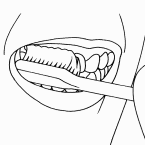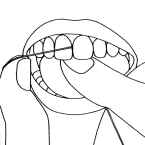| What is plaque?
Plaque is a sticky film of bacteria that forms on teeth and gums. Following a meal or snack, the bacteria in plaque release acids that attack tooth enamel. Repeated attacks can cause the enamel to weaken, eventually causing tooth decay. Many of the foods we eat cause plaque bacteria to produce acids. If you snack often, you could be having acid attacks all day long. Plaque that is not removed with thorough daily brushing and cleaning between teeth can eventually harden into calculus or tartar.
Plaque also produces substances that irritate
the gums, making them red, tender or
bleed easily. After a while, gums may
pull away from the teeth. Pockets form
and fill with more bacteria and pus.
If the gums are not treated, the bone
around the teeth can be destroyed. The
teeth may become loose or have to be
removed. In fact, periodontal (gum) disease is a main
cause of tooth loss in adults.
One way to prevent tooth decay and periodontal (gum)
disease is by eating a balanced diet
and limiting the number of between-meal
snacks. If you need a snack, choose nutritious
foods such as raw vegetables, plain yogurt,
cheese or a piece of fruit.
What are some tips for daily oral care?
The best way to remove decay-causing plaque
is by brushing and cleaning between your
teeth every day. Brushing removes plaque
from the tooth surfaces.
Brush your teeth twice a day, with a soft-bristled
brush. The size and shape of your brush
should fit your mouth, allowing you to
reach all areas easily. Use a toothpaste
that contains fluoride, which helps protect
your teeth from decay. When choosing
any dental product, look for the American
Dental Association Seal of Acceptance,
an important symbol of a dental product's
safety and effectiveness.
Cleaning between the teeth once a day
with floss or interdental cleaners removes
plaque from between the teeth, areas
where the toothbrush can't reach. It
is essential in preventing periodontal (gum) disease.
By taking care of your teeth, eating a
balanced diet and visiting your dentist
regularly, you can have healthy teeth
and an attractive smile your entire life.
Follow these tips to keep your teeth
and mouth clean:
How do I brush my teeth?
 Place your toothbrush at a 45-degree
angle against the gums. Place your toothbrush at a 45-degree
angle against the gums.
- Move the brush back and forth gently
in short (tooth-wide) strokes.
- Brush the outer tooth surfaces,
the inner tooth surfaces, and the
chewing
surfaces
of the teeth.
- Use the "toe" of the brush
to clean the inside surfaces of the
front teeth, using a gentle up-and-down
stroke.
- Brush your tongue to remove bacteria
and freshen your breath.
How do I floss my teeth?
 Break off about 18 inches of floss
and wind most of it around one of
your middle
fingers. Wind the remaining floss
around the same finger of the
opposite hand.
This finger will take up the
floss as it becomes dirty. Hold the
floss
tightly
between your thumbs and forefingers. Break off about 18 inches of floss
and wind most of it around one of
your middle
fingers. Wind the remaining floss
around the same finger of the
opposite hand.
This finger will take up the
floss as it becomes dirty. Hold the
floss
tightly
between your thumbs and forefingers.
- Guide the floss between your
teeth using a gentle rubbing
motion. Never snap the
floss into the gums.
- When the floss reaches the
gum line, curve it into
a C shape
against one
tooth. Gently slide it
into the space between
the gum and the tooth.
- Hold the floss tightly against the
tooth. Gently rub the side of the
tooth, moving
the floss away from the gum with
up and down motions.
- Repeat this method on the rest
of your teeth.
- Don't forget the back side
of your last tooth.
Watch the brushing and flossing animation to learn more.
People who have difficulty handling
dental floss may prefer to use
another kind
of interdental cleaner. These aids
include special brushes, picks
or sticks. If
you use interdental cleaners, ask
your dentist about how to use
them properly,
to avoid injuring your gums.
Please note: The ADA does not provide specific answers
to individual questions about fees, dental problems, conditions, diagnoses,
treatments or proposed treatments, or requests for research. Information about
dental referrals, complaints and a variety of dental procedures may
be found here. You can also refer to our Frequently
Asked Questions page for answers to common questions.
|

